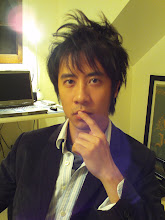Back in the ‘80s, movies like “The Karate Kid” and “Bloodsport” continued to excite martial arts enthusiasts long after the death of Bruce Lee. I was no exception. Stints in various martial arts filled my teenage years.
The reality, however, was sparring partners often sent my puny frame sprawling across the mat.
“Damn,” I would think to myself. “It’s probably time to find another hobby.”
Eventually I stumbled on something called taiko.
Literally translated as “big drum,” taiko has its roots in ancient
The popular brand of taiko today is ensemble drumming — and that is what I live, eat and breathe. If I could ditch my mundane retail job today, I would play taiko full-time.
Taiko is as much a visual treat as it is an audio masterpiece. Unlike usual percussion where people don’t break a sweat, taiko drumming extends a great deal of energy through strenuous movements. Most often, players take on low stances that are tiring on the knees. Not only do drummers get a workout, but the resulting coordinated mix of graceful yet powerful movements is an awe to behold.
In recent years, taiko groups have popped up in
Hopefully, if taiko makes it big like the martial arts boom of the ‘80s, I might just sellout on retail and pound on taiko for a living!

